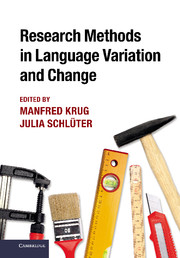20 - Analysing and interpreting variation in the sociolinguistic tradition*
Published online by Cambridge University Press: 05 June 2014
Summary
Foundations
Variationist Sociolinguistics is a descriptive-interpretive strand within linguistics (Sankoff 1988a: 142–143) that analyses features of a language that vary whether at the level of phonetics-phonology, morphology-syntax or discourse-pragmatics. The method may be used to study stable linguistic variation, for example variable (ing), the alternation between pronunciations of word final -ing in English (e.g. -ing as [ɪn], [ɪŋ], [ɪŋk], [ɪŋɡ] etc.) (Labov 1989; Tagliamonte 2004). It may also be used to study features undergoing change, for example the change in the history of English to do support (e.g. He knows not → He does not know) (e.g. Kroch 1989; Pintzuk 2003) or the more recent change to be like as the predominant quotative (e.g. I’m like, ‘Oh my god!’ and he’s like, ‘It’s true’). Whatever the variable under investigation, the type of analysis required is one that can model the simultaneous application of social and linguistic factors (a.k.a. predictors) and their interaction (Labov 1994: 3). Thus, Variationist Sociolinguistics has evolved over the past 40–50 years as a discipline that can account for these complex patterns of linguistic variation and change, and can interpret and explain them.
The key constructs of Variationist Sociolinguists include notions such as ‘the vernacular’, ‘orderly differentiation’, ‘the linguistic variable’, the ‘principle of accountability’ and ‘circumscription of the variable context’. The key statistical tool in this tradition is the ‘variable rule program’, a package embodying a standard logistic regression. This type of analysis exposes regularities and tendencies in the data and, more crucially, assesses what aspects of the external (social) or internal (linguistic) context favour the occurrence of variants and how strongly, and what factors disfavour them. Comparative techniques can also be implemented which permit the analyst to evaluate similarities and differences across relevant categorizations of the data (e.g. dialect, community, age, sex). Taken together, these techniques provide insights into the grammatical system and its social embedding, and therefore offer rich and viable explanations for language variation and change.
Information
- Type
- Chapter
- Information
- Research Methods in Language Variation and Change , pp. 382 - 401Publisher: Cambridge University PressPrint publication year: 2013
References
Accessibility standard: Unknown
Why this information is here
This section outlines the accessibility features of this content - including support for screen readers, full keyboard navigation and high-contrast display options. This may not be relevant for you.Accessibility Information
- 2
- Cited by
